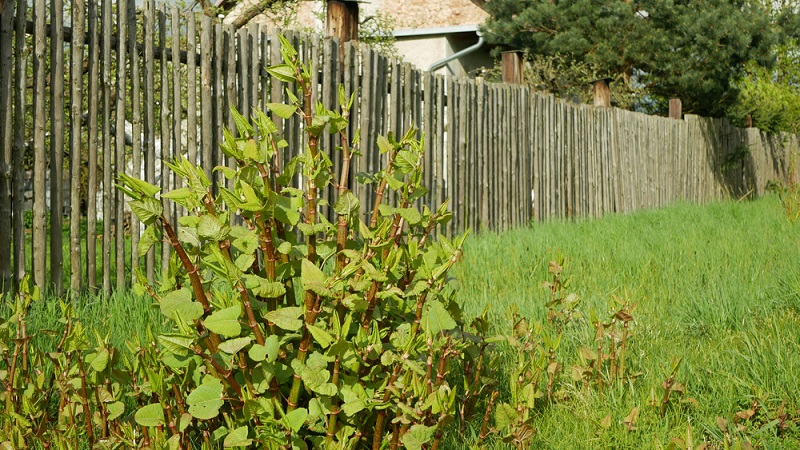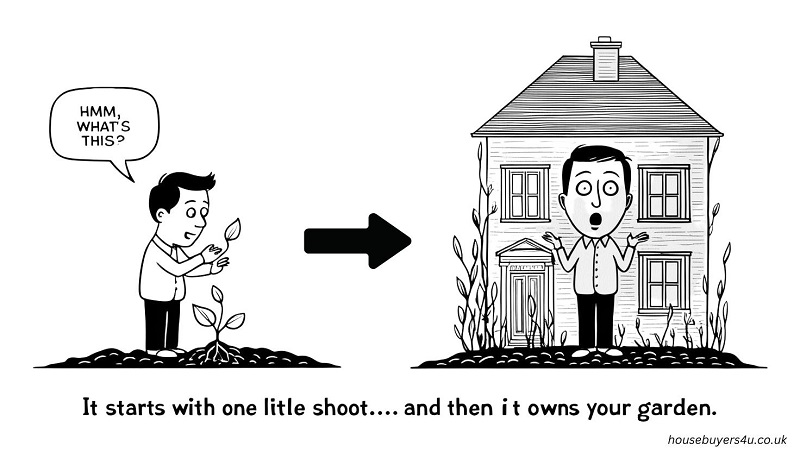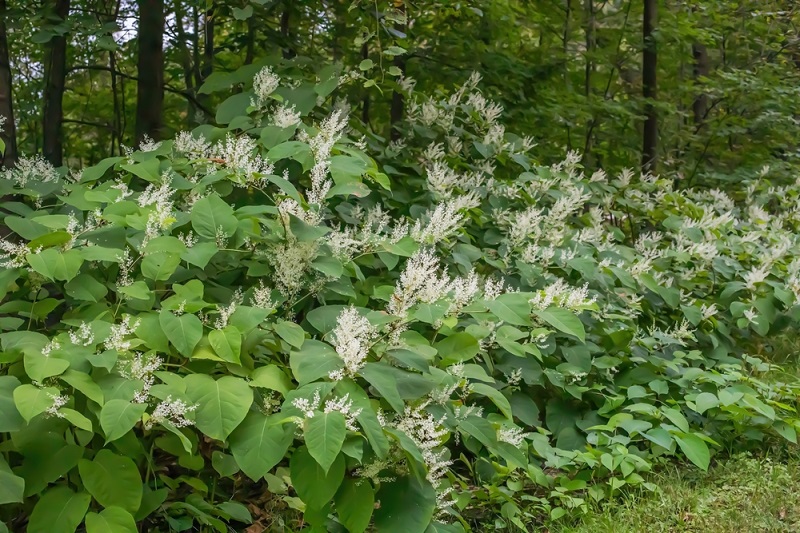What Is Japanese Knotweed? What It Looks Like & How To Kill It

Japanese knotweed is one of the most invasive plants in the UK, known for its rapid spread and ability to damage buildings, driveways, and gardens. It’s a major concern for homeowners, as its presence can affect property value and even make selling more difficult.
Key facts about Japanese knotweed:
- It grows rapidly, breaks through concrete, and is tough to control.
- Can impact property sales as lenders often require a management plan.
- DIY removal using cutting and glyphosate can work but takes 12-24 months with repeat treatments.
What Is Japanese Knotweed?
Japanese knotweed (Reynoutria japonica) is a fast-growing invasive plant with bamboo-like stems and broad leaves. Introduced to Europe and North America in the 19th century, it spreads aggressively, outcompeting native plants and causing structural damage with its deep roots. Its resilience makes removal difficult, often requiring professional treatment.
What Does Japanese Knotweed Look Like?
Japanese knotweed changes in appearance throughout the year. Here’s how to identify Japanese knotweed in different seasons:
| Season | Characteristics |
|---|---|
| Spring | - Bright red or purple shoots, resembling asparagus spears
- Rapid growth, turning green as they mature |
| Summer | - Grows up to 3 metres tall
- Hollow, bamboo-like stems with a greenish-red tinge - Heart-shaped or spade-like leaves arranged in a zig-zag pattern - Clusters of creamy-white flowers appear |
| Autumn | - Leaves start turning yellow before dying back
- Stems become brown and brittle - Underground roots (rhizomes) remain alive |
| Winter | - Stems appear dead and dry, standing tall
- Underground rhizomes remain active, ready to regrow in spring |
Because of its seasonal changes, this plant can be hard to spot until it’s well established. If you notice any of these signs, act quickly before it spreads further.
Related Read: When is the best month to sell your house?
What Does Japanese Knotweed Look Like When It Starts to Grow?
In its early stages, Japanese knotweed can be mistaken for other plants. It starts as red or purple shoots pushing through the soil in spring, resembling asparagus spears. These shoots grow rapidly, turning green as they mature.
Here’s a rough timeline of its growth:
-
Early Spring (March – April)
-
Small, reddish-purple shoots emerge from the ground
-
Shoots resemble asparagus spears but with a waxy surface
-
Growth is fast, sometimes several centimetres per day
-
-
Mid-Spring (April – May)
-
Shoots elongate and turn green as they develop
-
Leaves start to unfurl, appearing small and rolled at first
-
Stems thicken and begin showing their distinct hollow structure
-
-
Late Spring (May – June)
-
The plant reaches 1–2 metres in height
-
Leaves fully open and spread, growing in a zig-zag pattern along the stem
-
Stems become more rigid and bamboo-like
-
Pro tip from our property expert Paul:
"Japanese knotweed can take over gardens and land before you realise it’s there. Spotting it early is key to stopping its spread".
Can You Remove Japanese Knotweed Yourself?
It's technically possible to remove it, but it’s difficult. Japanese knotweed has an extensive underground root system (rhizomes) that can spread several metres and regrow from even the smallest fragment. While professional treatment is the most reliable solution, there are DIY methods you can try, especially for small infestations.
For DIY removal, the quickest method is cutting combined with strong glyphosate herbicide application (applied directly to cut stems). However, this still takes 12-24 months with repeat treatments to kill the roots fully.
How to Stop Japanese Knotweed from Spreading?
Stopping Japanese knotweed from spreading is not just about protecting your garden—it’s a legal and environmental issue too. In the UK, letting it spread to neighbouring properties or into the wild could lead to legal trouble. Plus, it grows so aggressively that ignoring it only makes the problem worse.
Here are the best ways to control it:
1. Chemical control
-
The most effective way to kill knotweed is with approved herbicides like glyphosate.
2. Mechanical control
-
Even a tiny piece of root or stem can regrow into a new plant. They can take root elsewhere if you didn't properly handle the cuttings.
-
If you attempted to remove the plant, the waste must be disposed of at licensed landfill sites—dumping it is illegal.
3. Root barriers
-
You may also install special root barriers to stop knotweed from spreading underground into neighbouring land. These are usually made of high-strength plastic sheeting, buried deep enough to block the rhizomes.
-
This process is best used as part of a wider management plan, especially if full removal isn’t possible.
4. Professional assistance
-
Because Japanese knotweed is so resilient, professional help is often the only reliable solution.
-
Experts use a combination of herbicide treatment, excavation, and root barriers to ensure long-term removal.
What Kills Japanese Knotweed Permanently?
Getting rid of Japanese knotweed for good isn’t easy, but it can be done with the right approach.
The UK government estimated in 2014 that controlling it would cost £1.25 billion, showing the scale of the problem. This has only increased now.
Because of its deep, spreading roots (rhizomes), simple methods like cutting it back won’t work. Instead, these are the most effective ways to eradicate it permanently:
1. Chemical treatments
-
You can use glyphosate-based herbicides which attack the plant at its roots.
-
It usually takes several applications over months or even years to fully kill the plant.
-
This method is best handled by professionals to meet UK legal requirements and avoid contamination of nearby land or waterways.
2. Excavation and disposal
-
You can dig out and remove the knotweed and surrounding contaminated soil for a quicker solution.
-
However, this method requires careful handling—knotweed waste is classed as controlled waste under UK law, meaning it must be disposed of at a licensed landfill site.
-
Any leftover fragments can regrow, so proper excavation depth is crucial (usually at least 3 metres deep).
3. Biological control
-
In some areas, scientists are testing Aphalara itadori, a tiny sap-sucking insect that feeds exclusively on Japanese knotweed.
-
While not a quick fix, this method aims to reduce the plant’s strength and slow its spread over time.
-
Currently, this approach is only being trialled in controlled environments and is not widely available for private use.
What is the Fastest Way to Kill Japanese Knotweed?
The fastest way to remove Japanese knotweed is excavation and disposal, which can be done in 1-2 weeks if carried out professionally. This involves digging at least 3 metres deep to remove all rhizomes and disposing of the waste at a licensed site.
Is Japanese Knotweed legal in the UK?
It’s not illegal to have Japanese knotweed on your property, but you must prevent it from spreading to neighbouring land. If you’re removing it, you can’t just throw it in the bin or compost—it must be disposed of legally at an approved site.
If you're selling your house, you’re legally required to declare the presence of knotweed on the TA6 property form.
Will Bleach Kill Japanese Knotweed?
No, bleach won’t kill Japanese knotweed permanently. While it might burn the Japanese knotwood leaves and stems, it won’t reach the root system, which is where the real problem lies.
Trying to use bleach is not only ineffective but also harmful to the soil and surrounding plants. If you’re serious about getting rid of knotweed, professional treatment is the safest and most reliable approach.
What Do Professionals Use to Kill Japanese Knotweed?
Professionals use strong, targeted herbicides to kill Japanese knotweed at its roots. The most common options include:
-
Glyphosate – The most widely used herbicide, applied directly to the leaves or injected into the Japanese knotweed stems.
-
Triclopyr – Effective for treating woody plants and can be used on knotweed in some cases.
-
Imazapyr – A powerful herbicide, though it can affect surrounding vegetation, so it’s used with caution.
Unlike DIY treatments, professional application follows strict UK environmental laws, ensuring the chemicals are used safely and effectively. Experts also monitor the site over time, applying repeat treatments if needed to fully eradicate the knotweed.
Since knotweed is so persistent, getting professional help is often the best way to remove it for good.
What is the 7 Metre Rule for Japanese Knotweed?
In the UK, the 7-metre rule is used to assess the risk Japanese knotweed poses to buildings. This guideline exists because knotweed rootscan spread up to 7 metres horizontally from where the plant is visible above ground.
Why does it matter?
-
If knotweed is found within 7 metres of a building, it could damage foundations, drainage systems, and walls over time.
-
Mortgage lenders take this seriously—many require a professional management plan before approving loans on affected properties.
-
The 7-metre rule is a risk-based guideline, not a legal requirement, but it’s widely used in property assessments.
Related Read: What do surveyors check when valuing a property
Expert insights from Paul:
"Japanese knotweed can seriously impact property sales and mortgages. I always advise homeowners and buyers to address it early."
The 7-metre rule matters—knotweed’s roots spread underground, affecting properties even from a distance. Lenders often demand a management plan, and ignoring it can delay or block sales.
Our Sales team recommend that buyers should get a survey, even if knotweed isn’t right against the house. Sellers should sort a treatment plan early to avoid last-minute issues.
Selling a Home with Japanese Knotweed? Housebuyers4u Can Help
Dealing with Japanese knotweed can be stressful, especially when it affects property sales and mortgage approvals.
At Housebuyers4u, we understand that not every homeowner has the time or resources to tackle knotweed before selling. That’s why we buy homes regardless of your EPC rating, property condition, or whether Japanese knotweed is present. We make the selling process simple, hassle-free, and without the need for costly treatments or surveys.
If you’re looking for a quick sale without the stress, get in touch with our expert team today.
Don't let Japanese Knotweed Delay Your Sale - Get a Cash Offer Today





